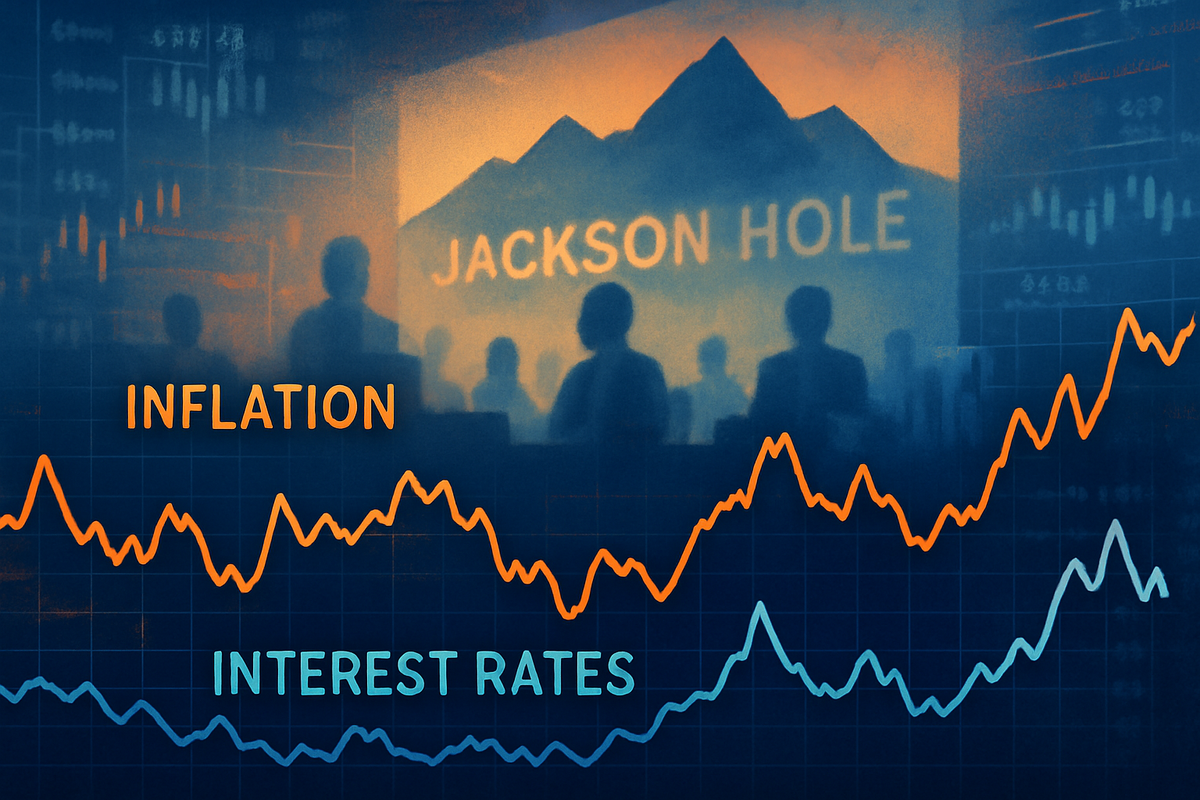
The financial markets are currently on tenterhooks, fixated on the Federal Reserve's next moves as a confluence of critical economic data and high-profile events converge. Investors are eagerly anticipating clarity on the future trajectory of interest rates, with hopes for cuts fueling a significant rally in U.S. equities. However, recent mixed signals from inflation reports, particularly the Consumer Price Index (CPI) and Producer Price Index (PPI), have introduced a layer of uncertainty, tempering some of the more aggressive rate-cut expectations.
All eyes are now firmly fixed on the upcoming Jackson Hole Economic Policy Symposium, where Federal Reserve Chair Jerome Powell's speech is widely expected to be a pivotal moment. His remarks will likely provide crucial insights into the Fed's assessment of the economy and its monetary policy outlook, potentially setting the tone for market performance in the coming months.
The Fed's Tightrope Walk: Balancing Inflation and Growth
The Federal Reserve finds itself navigating a delicate balance between taming persistent inflation and supporting economic growth. Since December 2024, the Fed has maintained its benchmark interest rate in a range of 4.25% to 4.50%, following a series of cuts initiated in late 2024. This period of stability has been punctuated by intense speculation about when the central bank will resume its easing cycle.
Investor hopes for interest rate cuts have been largely driven by signs of a softening labor market and inflation that, despite some recent upticks, is perceived to be growing less than initially feared. Money markets are currently pricing in a near 95% chance of a 25-basis-point rate cut by the Federal Open Market Committee (FOMC) meeting in September 2025. Some analysts are even debating the possibility of a more aggressive 50-basis-point cut, particularly if labor market data continues to weaken. The immediate implications of these expectations are evident in the stock market, which has rallied to near all-time highs, reflecting a collective bet on a "soft landing" for the economy.
However, the path to rate cuts is not without its bumps. Recent inflation reports have presented a mixed picture, creating volatility in market expectations. The July Consumer Price Index (CPI) data was relatively "tame," initially boosting hopes for a September rate cut. This optimism, however, was quickly tempered by a surprising surge in the Producer Price Index (PPI), which indicated a significant rise in wholesale inflation (0.9% month-over-month and 3.3% year-over-year). This hotter-than-expected PPI data has caused some moderation in rate cut expectations and unsettled both equity and bond markets. Furthermore, core inflation, which excludes volatile food and energy prices, remains stubbornly above the Fed's 2% target, currently around 3.1% year-over-year, complicating the Fed's decision-making process.
The Jackson Hole Economic Policy Symposium, scheduled for August 22-24, 2025, is poised to be a "policy-defining moment." Federal Reserve Chair Jerome Powell's speech on August 22, themed "Labor Markets in Transition," is expected to clarify the Fed's strategy for balancing price stability and maximum employment. Historically, this symposium has been a platform for the Fed to signal major policy shifts, making Powell's remarks a critical juncture for investors seeking guidance on the timing and magnitude of potential rate cuts. The Fed also faces considerable political pressure to lower rates, adding another layer of complexity to Powell's address.
Navigating the Tides: Potential Winners and Losers in a Shifting Rate Environment
The Federal Reserve's monetary policy decisions have far-reaching implications, creating distinct winners and losers across various sectors and companies. The prospect of interest rate cuts, while generally positive for the broader market, will disproportionately benefit certain industries and firms, while others may face headwinds.
Companies with high levels of debt, particularly those in capital-intensive sectors, stand to be significant beneficiaries of lower interest rates. Reduced borrowing costs can free up capital for investment, expansion, or debt repayment, directly boosting their bottom lines. Real estate investment trusts (REITs) like Prologis (NYSE: PLD) and homebuilders such as D.R. Horton (NYSE: DHI) are prime examples. Lower mortgage rates, a direct consequence of Fed rate cuts, can stimulate housing demand and make real estate investments more attractive, leading to increased sales and property values. Similarly, utility companies like NextEra Energy (NYSE: NEE), which often carry substantial debt for infrastructure projects, would see their financing costs decrease, improving profitability.
Conversely, a sustained period of lower interest rates can pose challenges for financial institutions, particularly banks. While lower rates can stimulate loan demand, they also compress net interest margins (NIMs)—the difference between what banks earn on loans and what they pay on deposits. Major banks such as JPMorgan Chase & Co. (NYSE: JPM) and Bank of America Corp. (NYSE: BAC) could see their profitability squeezed if rates fall too quickly or too far. Additionally, sectors that thrive on higher interest rates, such as certain segments of the insurance industry, might experience reduced investment income. Companies with strong cash positions and minimal debt, while generally resilient, might see their interest income on cash holdings diminish in a lower-rate environment.
Broader Implications: Industry Shifts and Policy Echoes
The Federal Reserve's current stance and anticipated actions are not merely isolated events; they are integral to broader industry trends and carry significant regulatory and policy implications. The ongoing debate about interest rates fits into a larger narrative of economic normalization post-pandemic, with central banks globally grappling with persistent inflation and varying degrees of economic recovery.
A shift towards lower interest rates could significantly impact the technology sector, particularly growth-oriented companies like Microsoft Corp. (NASDAQ: MSFT) and Apple Inc. (NASDAQ: AAPL). These companies often rely on future earnings potential for their valuations, and lower discount rates (a result of lower interest rates) make those future earnings more valuable in present terms, potentially fueling further stock appreciation. Conversely, a more hawkish stance from the Fed, or a delay in rate cuts, could lead to a re-evaluation of these high-growth stocks, as their future earnings become less attractive when discounted at higher rates. The ripple effects extend to venture capital and private equity, where the cost of capital directly influences investment decisions and valuations of startups and private companies.
Regulatory bodies and policymakers are also closely watching the Fed's actions. The potential for new tariff policies, as highlighted in recent research, could introduce additional inflationary pressures through higher import costs. This would complicate the Fed's efforts to manage inflation and could lead to a more prolonged period of elevated interest rates, or at least temper the pace of cuts. Historically, periods of high inflation followed by aggressive monetary tightening have often led to economic slowdowns or recessions. The current situation draws parallels to the late 1970s and early 1980s, when the Fed, under Paul Volcker, aggressively raised rates to combat runaway inflation, albeit with significant economic pain. The challenge for Chair Powell is to avoid a similar outcome while still achieving the Fed's dual mandate.
What Comes Next: Navigating the Uncharted Waters
The immediate future for financial markets hinges significantly on the Federal Reserve's communications and subsequent economic data. In the short term, all eyes will be on Federal Reserve Chair Jerome Powell's speech at the Jackson Hole Symposium on August 22. A "dovish" outcome, where Powell signals an imminent September rate cut, would likely lead to further U.S. dollar weakness and could fuel additional rallies in the stock market, particularly for growth stocks and sectors sensitive to interest rates. Conversely, a "hawkish" stance, where Powell refrains from signaling an immediate cut or emphasizes the need for continued vigilance against inflation, could result in a sharp decline in the stock market and an increase in short-term interest rates and the U.S. dollar.
Looking further ahead, the path of inflation and the strength of the labor market will be paramount. If inflation continues to show signs of cooling, even with occasional upticks, and the labor market continues to soften, the Fed will have more room to implement rate cuts. This could lead to a sustained period of lower borrowing costs, potentially stimulating investment and consumer spending. However, if inflation proves more persistent, or if new geopolitical or supply chain disruptions emerge, the Fed might be forced to maintain higher rates for longer, or even consider further tightening, which would present significant challenges for businesses and consumers alike.
Potential strategic pivots for companies will involve optimizing their capital structures to either take advantage of lower borrowing costs or to weather a prolonged period of higher rates. Market opportunities may emerge in sectors that are poised to benefit from an easing monetary policy, such as housing, technology, and certain consumer discretionary segments. Conversely, challenges will persist for industries sensitive to higher input costs or those reliant on robust consumer spending in a potentially tighter credit environment. Investors should prepare for various scenarios, from a "soft landing" with gradual rate cuts to a more challenging environment if inflation proves stubborn or economic growth falters.
Conclusion: A Pivotal Moment for Markets
The current period represents a pivotal moment for financial markets, with the Federal Reserve's actions and communications serving as the primary determinant of future direction. The interplay between investor hopes for interest rate cuts, the mixed signals from recent inflation data, and the highly anticipated Jackson Hole Symposium creates a complex and dynamic environment. The market's current optimism, reflected in near all-time high stock valuations, is largely predicated on the expectation of an accommodative Fed.
The key takeaway for investors is the critical importance of monitoring not just the Fed's explicit statements, but also the underlying economic data, particularly inflation and employment figures. While a September rate cut appears highly probable according to money markets, the magnitude and pace of subsequent cuts remain uncertain. The Jackson Hole Symposium will offer crucial insights into the Fed's thinking, but it is the subsequent FOMC meetings and ongoing economic releases that will ultimately dictate the trajectory of monetary policy.
Moving forward, investors should watch closely for any shifts in the Fed's language regarding its dual mandate, particularly how it balances price stability with maximum employment. The persistence of core inflation and the potential impact of new tariff policies will be key factors influencing the Fed's decisions. Companies with strong balance sheets and adaptable business models will be best positioned to navigate the evolving economic landscape. The coming months will undoubtedly be characterized by continued volatility as the market digests new information and adjusts its expectations for the Federal Reserve's path forward.





